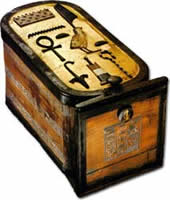
Cartouche
(shenu)
Appearance: The cartouche is an elongated version of the shen ring. The Egyptian name for the cartouche, shenu, is derived from the same verb, "sheni" (to encircle), as the shen ring. The modern name came from Napolean's soldiers during his expedition to Egypt. The sign reminded them of the cartridges, "cartouches", used in their guns.
Meaning: The cartouche was the place holder for the name of the pharoah. As it is descended from the shen ring, the earliest examples of the cartouche were in fact circular and identical to that sign. Soon though, the ring was lengthened to hold the larger number of hieroglyphs in the pharaoh's name. By the 5th dynasty, the pharaoh's two most important names (he had five or more), his nomen (birth-name) and prenomen (throne name) were enclosed in cartouches.
The cartouche had clear solar symbology. It originally represented everything that was encircled by the sun -- the king's realm.
However, the cartouche was also a protective symbol for the king. In the Eighteenth Dynasty, royal sarcophagi were constructed in the shape of the cartouche. The entire burial chamber of Thutmose III and the sarcophagus was in the this shape. It seems fitting that the king's final resting place would be representative of his name and person.
The cartouche was also used in many decorative ways. For instance the box shown to the left was found in King Tutankhamun's tomb. The symbols on the lid are in fact his name. Finger rings were also made in the shape of the cartouche.
Finally, partially personified cartouches were found on many palace walls. Inside the ring would be the name of cities and subject peoples the king dominated during his reign.
Digg This!
![]() Del.icio.us
Del.icio.us
![]() Stumble Upon
Stumble Upon
